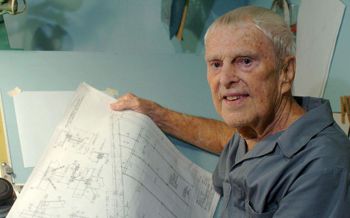
Home - Search - Browse - Alphabetic Index: 0- 1- 2- 3- 4- 5- 6- 7- 8- 9
A- B- C- D- E- F- G- H- I- J- K- L- M- N- O- P- Q- R- S- T- U- V- W- X- Y- Z
Holderer, Oskar F
 Holderer Holderer, Oskar F |
Born: 1919-11-04. Died: 2015-05-05. Birth Place: Frum.
German expert in guided missiles during World War II. Member of the German rocket team, arrived in America under Project Paperclip on 16 November 1945 aboard the Argentina from La Havre. Fluent in English prior to arrival in United States. Worked his entire life with the rocket team, at Fort Bliss, White Stands, and then at Huntsville. Still living in Huntsville, Alabama in 2004.
Obituary: Oscar Holderer, who has died aged 95, was the last known survivor of the team of German rocket scientists who moved to America after the Second World War under the leadership of Wernher von Braun, and worked on the Saturn V rocket which launched the crew of Apollo 11 on the first manned space flight to the moon in 1969.
When the Allies advanced into Germany during the final days of the war, American and Soviet armies rushed in from opposite directions to grab the spoils of the German rocket programme and the scientists who had developed the V-2, the world’s first long-range guided ballistic missile. The Russians captured the German rocket centre at Peenemünde, an underground production factory and a collection of unused V-2s. But the programme’s director, the 33-year old Wernher von Braun and 126 fellow scientists surrendered to the Americans, bringing with them a collection of top-secret technical papers.
Through “Operation Paperclip”, the Germans signed work contracts with the US government and were spirited away to America by the Office of Strategic Services. Within weeks, they were sent to Fort Bliss, the US missile testing station covering more than 1,000 square miles of New Mexico and Texas, where they were soon busily employed designing rockets that would give America the edge in the Cold War. Later they moved to Redstone Arsenal, Huntsville, Alabama, where they used early computers and slide rules to design the Saturn V.
Oscar Carl Holderer was born on November 4 1919 in Prüm, Germany, and, after training as an engineer, became a wind-tunnel designer and aeroballistics expert on the German rocket programme.
In America he designed the high-speed wind tunnel used in the Saturn project and also designed the US Space Program’s multi-axis trainer, 5DF, and a one-sixth gravity chair which is still in use at the Space and Rocket Center in Huntsville.
Some years after the war, attention began to focus on the activities of some of von Braun’s team during the war and in particular the use of slave labour in the V-2 factories. In the early 1980s Arthur Rudolph, the former chief engineer of the V-2 rocket factory at Peenemünde, who later worked for the Americans as project manager of the Pershing missile project and played a key role on Saturn V, was pressurised into renouncing his American citizenship and returning to West Germany. But Holderer, who took US citizenship in 1955, never faced questions over his Nazi connections or wartime role and was proud to be an American.
Unlike many of his colleagues, who moved to houses near each other on or near Huntsville Monte Sano mountain, he chose to live in north-west Huntsville and become part of the local community. Visitors were sometimes offered tours of the machine shop he had built at his home.
Holderer is survived by his wife, Jan, and by two sons.
Country: Germany, USA. Bibliography: 1980.
1919 November 4 - .
- Birth of Oskar F Holderer - . Nation: Germany, USA. Related Persons: Holderer. German engineer in WW2, member of the Rocket Team in the United States thereafter..
2015 May 5 - .
- Death of Oskar F Holderer. - . Related Persons: Holderer. German engineer in WW2, member of the Rocket Team in the United States thereafter..
Back to top of page
Home - Search - Browse - Alphabetic Index: 0- 1- 2- 3- 4- 5- 6- 7- 8- 9
A- B- C- D- E- F- G- H- I- J- K- L- M- N- O- P- Q- R- S- T- U- V- W- X- Y- Z
© 1997-2019 Mark Wade - Contact
© / Conditions for Use